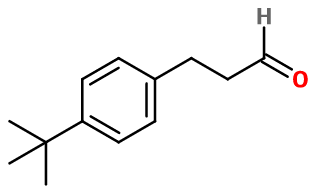Bourgeonal
Synthétique
Floral > Light Flowers > Aldehydic > Aquatic > Green

Crédits photo: ScenTree SAS
Other names :
Burgenal ; 3-(4-tert-butylphenyl)propanal ; 4-(1,1-dimethylethyl)-benzenepropanal ; Para-tertbutyl dihydrocinnamaldehyde ; Para-tertbutyl dihydrocinnamic aldehyde ; 3-(4-tert-butylphenyl)propionaldehyde ; 4-(1,1-dimethyl ethyl) benzene propanal ; Langeonal ; Lilional ; Liliphenal ; 3-[4-(2-methyl-2-propanyl)phenyl]propanal
Volatility :
Heart
Uses in perfumery :
Bourgeonal is used in all types of perfumery, in floral-aldehydic, green notes. Often used for its stability in soap and detergent bases, in addition to alcoholic perfumery.
Natural availability :
Bourgeonal is not available in its natural state.
Year of discovery :
1959
Other comments :
Compared to Lilial® or Silvial®, Bourgeonal is a floral-aldehydic molecule also having a green note, making the difference with other molecules of this type.
Price Range :
€€
Stability :
Aldehydes may form diethylacetals in alcoholic perfumes, with no real impact on their smell
Most of the time, the occurrence of a benzenic cycle in a molecule causes a coloration of this molecule through time
Exclusively stable in fabric conditioners, shampoos and hair conditioners.
Most of the time, the occurrence of a benzenic cycle in a molecule causes a coloration of this molecule through time
Exclusively stable in fabric conditioners, shampoos and hair conditioners.

Crédits photo: ScenTree SAS
- Molecular formula :
- C13H18O
- Molecular Weight :
- 190,28 g/mol
- Density :
- 0,961
- Flash Point :
- 73°C
- Fusion Point :
- -11°C
- Appearance :
- Colorless liquid
- Log P :
- 3,2
- Boiling Point :
- 207°C
- Detection Threshold :
- 0,4 ng/L air
Synthesis route :
Bourgeonal can be synthesized from 4-tert-Butyl benzaldehyde by an aldol reaction with Acetaldehyde. The intermediate product that is obtained is 4-tert-Butyl Cinnamaldehyde. A catalytic hydrogenation converts this intermediate into Bourgeonal. Another synthetic route reacts 4-tert-Butyl benzene with acrolein diacetate in the presence of a Lewis acid.
Then, the intermediate product is subjected to a saponification.
Synthesis precursor :
Bourgeonal forms a Schiff base by reaction with Methyl Anthranilate or Indole for example.
Isomerism :
The meta and ortho isomers of Bourgeonal are not used in perfumery.
Cyclamen Aldehyde is a positional isomer of Bourgeonal. However, its smell is quite different, as it is more marine. Both have an aldehydic and floral-white flowers smell.
- EINECS number :
- 242-016-2
- FEMA number :
- Donnée indisponible.
- JECFA number :
- Donnée indisponible.
- FLAVIS number :
- Donnée indisponible.
- Allergens :
- This ingredient does not contain any allergen.
- IFRA :
- This ingredient is restricted by IFRA
- Restriction type :
- RESTRICTION
- Cause of restriction :
- DERMAL SENSITIZATION AND SYSTEMIC TOXICITY
- Amendment :
- 49
- Quantitative limit on the use :
-
Cat.1 Cat.2 Cat.3 Cat.4 Cat.5A Cat.5B Cat.5C Cat.5D Cat.6 0,0041 % 0,025 % 0,025 % 0,47 % 0,12 % 0,029 % 0,037 % 0,0096 % 0,087 % Cat.7A Cat.7B Cat.8 Cat.9 Cat.10A Cat.10B Cat.11A Cat.11B Cat.12 0,029 % 0,029 % 0,0096 % 0,099 % 0,099 % 0,24 % 0,0096 % 0,0096 % 6,9 % - Restriction type :
- RESTRICTION
- Cause of restriction :
- DERMAL SENSITIZATION AND SYSTEMIC TOXICITY
- Amendment :
- 49
- Comments :
- For Oakmoss and Treemoss extracts, the restrictions in the Standards are directly linked to the presence of Atranol and Chloroatranol in the finished products. To ensure that those remain below trace levels, the upper concentration levels have not been increased (compared its last publication in the Amendment 43 (2008)). In the presence of Treemoss extracts, the level of Oakmoss in the respective category has to be reduced accordingly, such that the total amount of both extracts does not exceed the maximum permitted level in each category as listed in the table above. If the same fragrance mixture is intended to be used in more than one IFRA Category, then the most restrictive limitation (based on foreseen use concentrations and maximum permitted level) will apply. Oakmoss extracts must not contain added Treemoss, which is a source of resin acids. Traces of resin acids may be carried over to commercial qualities of Oakmoss in the manufacturing process. These traces must not exceed 0.1% (1000 ppm) of Dehydroabietic acid (DHA) in the extract. The concentration of resin acids in Oakmoss can be measured with an High Performance Liquid Chromatography (HPLC) Reverse Phase – Spectrofluorometry method. Further, levels of Atranol and Chloroatranol should each be below 100 ppm in Oakmoss extracts.
- Quantitative usage limits :
-
Cat.1 Cat.2 Cat.3 Cat.4 Cat.5 Cat.6 Cat.7 Cat.8 Cat.9 Cat.10 Cat.11 0,0041 % 0,025 % 0,025 % 0,47 % 0,12 % 0,087 % 0,029 % 0,0096 % 0,099 % 0,099 % 0,0096 %
To learn more about IFRA's standards : https://ifrafragrance.org/safe-use/library
ScenTree is solely responsible for the information provided here.

